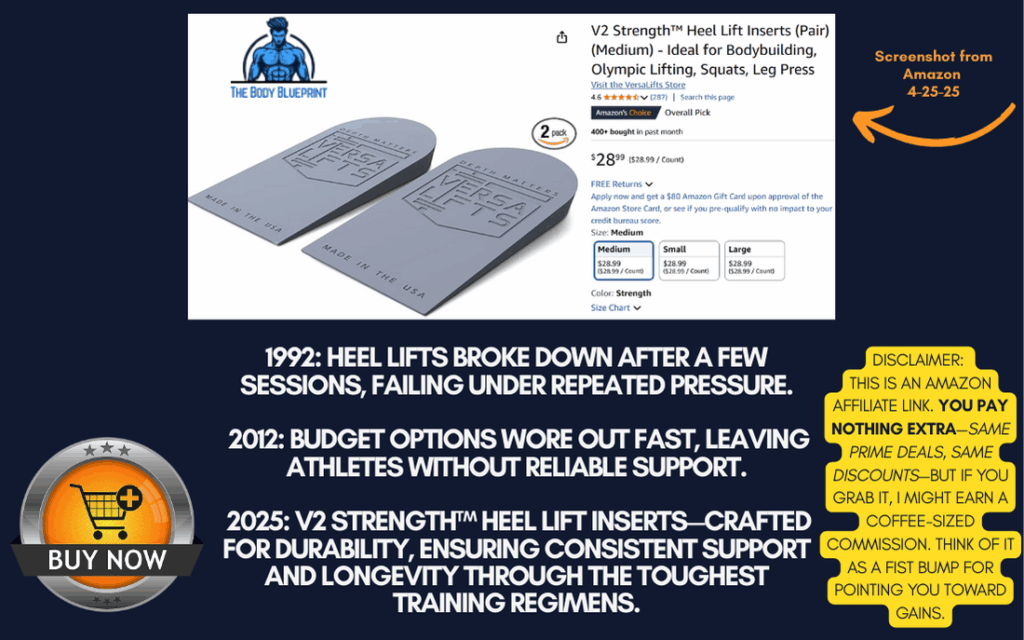Picture this: You’re mid-squat, knees tracking forward, chest up—but your heels peel off the floor like overcooked bacon. Sound familiar? Enter V2 Strength™ Heel Lift Inserts. These rigid, 5mm wedges promise to fix your squat mechanics, boost Olympic lifts, and maybe even save your ankles. But let’s get real: Are they a game-changer or just glorified shoe stuffing? No fluff. No hype. Let’s break it down like a PR attempt.
What Are Heel Lift Inserts? (Spoiler: Not Your Grandpa’s Orthotics)
The V2 Strength™ Inserts are thin, rigid wedges made to slide into your shoes, giving you a subtle heel-to-toe drop (5mm). Think of them as “cheat codes” for ankle mobility—ideal for lifts where heel elevation matters, like squats or cleans. Unlike bulky weightlifting shoes (Nike Romaleos, VersaLifts®), these inserts are minimalist tools designed to tweak your existing kicks.
“A slight heel lift shifts your center of gravity forward, reducing strain on the Achilles and improving squat depth,” says Eugene Thong, CSCS. “But it’s a scalpel, not a sledgehammer.”

Who Should Buy Them (And Who Should Walk Away)
✅ FOR:
- Lifters with tight ankles or poor dorsiflexion.
- Cross-training athletes mixing squats, Olympic lifts, and plyometrics.
- Anyone who wants versatility without buying three pairs of shoes.
- Your gym bag if: You’re tired of standing on weight plates mid-workout.
🚫 NOT FOR:
- Runners or endurance athletes (these aren’t cushioned).
- Folks with plantar fasciitis (rigid inserts might aggravate it).
- Casual lifters who don’t care about squatting ATG.
V2 Strength™ Inserts: The Unfiltered Pros & Cons
| Pros | Cons |
|---|---|
| Adds 5mm heel lift to any shoe | Not ideal for running/jumping |
| Durable enough for 500lb+ squats | Rigid design risks foot pain for some |
| Cheap fix vs. buying weightlifting shoes | Sizing can be finicky (measure twice) |
“Heel lifts are like a Swiss Army knife,” says Charles Damiano, B.S. Clinical Nutrition. “They solve one problem elegantly—but won’t replace a toolbox.”
Heel Inserts vs. Weightlifting Shoes: The Showdown
- Weightlifting Shoes (e.g., VersaLifts®): Built-in 20mm heel, stable, but only for lifting.
- V2 Inserts: 5mm lift, work in cross-trainers, sneakers, even boots.
- Standing on Plates: Free, but sketchy AF mid-WOD.
Winner for versatility? Inserts. For max stability? Grab dedicated shoes.

The Science of Heel Elevation: Why 5mm Matters
Elevating your heel shifts your squat stance into a more upright torso position, reducing shear force on knees and lower back. The 5mm lift is the Goldilocks zone—enough to improve mobility without turning your gait into a wobbly mess. It’s the biomechanical sweet spot between barefoot and block heels.
“Can’t I Just Use Weight Plates?”
Sure—if you enjoy balancing on a 45lb disc like a circus bear. Inserts give you the same lift without the ankle roll risk. Plus, they won’t scuff your gym’s equipment.
Uncommon Questions You Haven’t Thought to Ask (But Should)
A: If used as a crutch without addressing underlying mobility issues, yes. The inserts improve positioning temporarily, but relying on them exclusively can lead to lazy ankles. Pair them with dynamic stretches and calf work to avoid dependency.
A: Irony alert: Sliding a heel lift into a zero-drop shoe turns it into a *5mm-drop shoe*. It’s not “defeating” the purpose—it’s repurposing. Useful for lifters who want barefoot feel and a subtle boost during squats.
A: Technically, yes—but you’ll trade stability for elevation. Stacking creates uneven pressure points and a wobbly base. Better to invest in proper weightlifting shoes with a built-in 20mm heel if you need drastic lift.
A: Absolutely. The rigid lift changes your foot’s contact angle with the ground, shifting force distribution to the forefoot. For plyometrics, this can improve rebound power—but test cautiously. Some athletes find it throws off their timing.
A: Only if you want your feet to revolt. The rigid design lacks cushioning for walking, and chronic use outside the gym can strain arches or Achilles tendons. Treat them like a tool, not a lifestyle upgrade.
A: Surprisingly, yes. The heel lift subtly improves overhead alignment by tilting your pelvis forward, creating a stronger base for stability. Just don’t expect miracles—it’s a minor tweak, not a form fixer.

The Final Verdict
If you’re serious about squats, cleans, or snatches, these inserts are worth their weight in gains. They’re not magic, but they are a cheap, clever fix for mobility woes. For everyone else? Stick with your beat-up Chucks.
YOUR NEXT STEPS:
